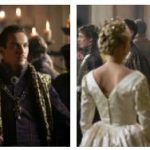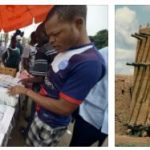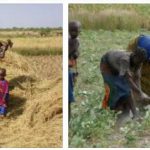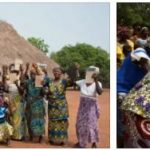1983-1987: The Conseil National de la Révolution (CNR)
The four years of the revolution from 1983 to 1987 were strongly shaped by the personality of Thomas Sankara. His politics were characterized by charismatic rule. He ruled the country externally and internally out of a strong and uncompromising sense of justice. His ambition was to let the people become active, to take their own fate into their own hands (video: Der Che Afrikas) in order to live in freedom and dignity. No other Burkinabe president thought so pan-African and at the same time so enlightened European as Sankara and none fought so resolutely against the patriarchal tradition.
While the previous governments wanted to develop the country through short-term, cost-intensive industrialization, to inflate the state apparatus and to rely on the military, in Sankara’s opinion the development of the country depended on the will and the skills of the rural population. This is where he started to redesign a state apparatus in which the will of the people could develop. At the core of this apparatus was the council of four of the four historical leaders of the revolution, the officers Thomas Sankara, Blaise Compaoré and Henri Zongo and Jean-Baptiste Lingani. Among them was the highest decision-making body of the CNR (Conseil National de la Révolution), which consisted of 20 – 60 revolutionary-minded leaders and military of the country. The often changing and not very transparent composition of the CNR was intended to rule out nepotism, preferential treatment and political careers from the outset. From the CNR, the government emerged from mostly civilians. The interface between the people and the CNR was formed by the local CDR (Comités de Défense de la Révolution), which were represented by grassroots democracy at all levels of public life and whose task was the development of the people on the grassroots.
In terms of foreign policy, the new revolutionary leadership followed a strictly anti-imperialist course by criticizing the hegemony of individual countries and exposing the upheavals of globalization. She remained emphatically free of blocks. The focus was on the independence and self-determination of all peoples. Burkina Faso took on all countries that were considered neocolonial, that is, played off economic and military superiority against African peoples or revolutionary countries such as Nicaragua and Cuba or that supported the apartheid regime in South Africa. In particular, Sankara approached France and the USA with a very open language. Before the African Union, he called on all African states not to repay their debts.
Economically – supported by slogans like “consommons burkinabé” propagandistically – in-house production and domestic market were promoted, for example officials had to wear clothes from national production, the Faso dan Fani. Bottled beer was brewed from local millet, not according to a Bavarian recipe (but this soon had to be reversed for reasons of taste).
Domestically, the focus was on the struggle for social justice. Privileges have been removed. Sankara started with himself first by cutting his salary and giving the President’s Mercedes to the state lottery to exchange for a used Renault 5. He flew in economy class or asked for opportunities to fly, etc.
According to cheeroutdoor, the country was renamed from Upper Volta to Burkina Faso (“Land of the incorruptible”) as part of an anti-corruption program, for which people’s courts (TPR Tribunal Populaire Révolutionnaire) were set up with radio and television broadcasts. The TPR were extremely effective in propaganda as they were able to expose the class that had ruled for decades as thieves, even to illiterate people. The penalties for corruption cases were rather mild, for example “planting two hectares of forest”. Such penalties also underscored the great importance that environmental protection now had. Every elementary school pupil was familiar with the “trois luttes”: fighting bushfires, deforestation and overgrazing.
With CDR and TPR, Sankara had created the two instruments with which he secured his policy on a broad basis against bourgeois-conservative and reactionary forces and created a counterweight to the power of the traditional bosses.
Popular development plans (PPD programme populaire de développement and plan quinquennal) made it possible to increase the school attendance rate, improved public health (construction of medical stations, vaccination campaigns), the construction of social housing, construction of wells, retention basins and irrigation systems and promoted equality for women(Access to agricultural land, fight against polygamy, forced marriage, bride price, genital mutilation …). Most of these development projects were implemented with the active contribution of the population. Burkina Faso even received praise from the World Bank for its economic pragmatism in restructuring state-owned companies. Civilian life in the city was moralized by the fight against prostitution and excessive alcohol consumption, and civil servants were disciplined. Popular sport became a duty. Prisoners were rehabilitated as victims of social injustice. On the national holiday, the ministers ‘team played a football match against the prisoners’ team.
The construction of the railroad by its own efforts, stylized as a patriotic struggle, Bataille de Rail, became – when the expansion turned out to be unprofitable – the first major fiasco of the revolution. Many measures – as correct as they were epistemological – turned out to be practically hasty, unfounded and unsustainable. The bandit-like actions of underage CDR cadres, to whom weapons were lightly distributed, created more and more opposition to the revolution. Sankara admitted the revolution’s mistakes and promised to demand fewer sacrifices from the people in the next year (1988). But he didn’t see the next year again.
What qualitatively differentiated Sankara from the type of African president and what makes it live on as a myth throughout Africa today : He authentically perverted the self-image of all his predecessors and, above all, that of his successor. The president and rulers in Sankara’s time had to serve the people instead of serving themselves. What was extraordinary was that his speeches were followed by deeds. By giving hearing and recognition to the lawless, Sankara became a hope for a fundamental change in the status quo. Even if the time of the revolution was no more bloodless than others, it was determined like no other by the human spirit, not by the voracious stomach of a ruling political elite. Sankara is today symbolic figure of the “anti-globalists”.








